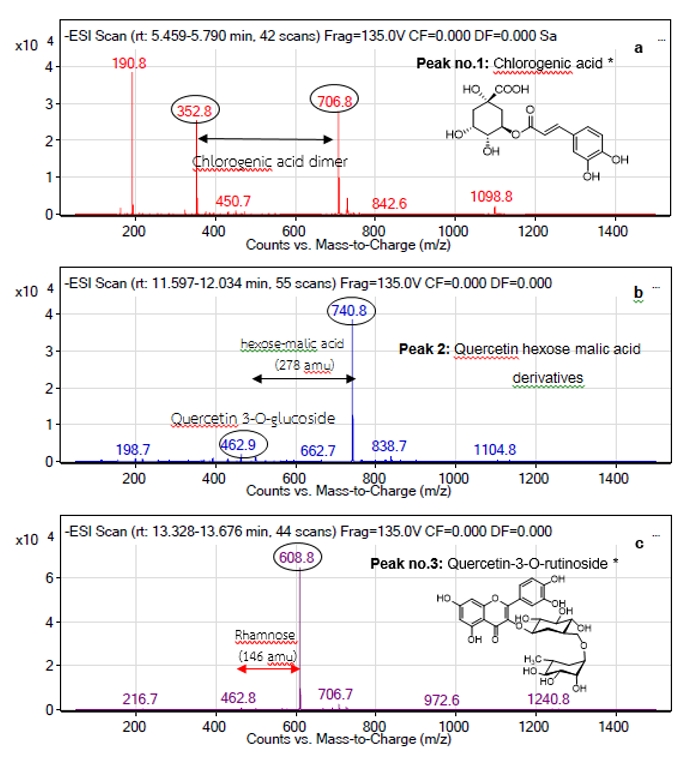Composition of phenolic compounds and antibacterial activities of Paederia pilifera Hook. f. leaf extract
Keywords:
Antibacterial activity, Flavonoids, Paederia pilifera, Phenolic compoundsAbstract
In this study, phenolic compounds were extracted from Paederia pilifera Hook. f. leaves. The phenolic compositions of crude extract were determined by Liquid Chromatography - Mass Spectrometry (LC-MS). Phenolic acids and flavonoids were identified as the major phenolic compound compositions in the crude extract. Furthermore, crude extract was performed to evaluate the antibacterial activities against 3 human pathogenic strains: Staphylococcus aureus DMST 8840, Staphylococcus epidermidis DMST 15505 and Methicillin-resistant Staphylococcus aureus (MRSA) DMST 20651. The results revealed that P. pilifera crude extract exhibited antibacterial activities against all tested bacterial strains with a minimal inhibitory concentration (MIC) value of 25.60 mg/mL and minimal bactericidal concentration (MBC) value of 51.20 mg/mL for S. aureus and MRSA, and 25.60 mg/mL for S. epidermidis.
References
Krishnaiah D, Sarbatly R, Nithyanandam R. A review of the antioxidant potential of medicinal plant species. Food Bioprod Process. 2011;89 (3):217-33.
Dai J, Mumper RJ. Plant phenolics: extraction, analysis and their antioxidant and anticancer properties. Molecules. 2010;15(10):7313-52.
Hertog MGL, Feskens EJM, Hollman PCH, Katan MB, Kromhout D. Dietary antioxidant flavonoids and risk of coronary heart disease: the Zutphen Elderly Study. Lancet. 1993;342 (8878):1007-11.
Chanda S, Rakholiya K. Combination therapy: Synergism between natural plant extracts and antibiotics against infectious diseases. In: Mendez-Vilas A (Ed), Science against microbial pathogens: communicating current research and technological advances. Badajos/Spain: Formatex. 2011:520-9.
Saenphet K, Saenphet S, Jirakittirat K. Gastroprotective effects and antioxidant activities of Paederia pilifera Hook. f. root extract. Chiang Mai J Sci. 2014;41(5.1):1121-31.
Siramon P, Wongsheree T. Ultrasonic-assisted extraction of phenolic compounds from Paederia pilifera Hook. f. leaves and its antioxidant activity. Prawarun Agr J. 2019; 16(1):182-9.
Lee SJ, Kim JJ, Moon HI, Ahn JK, Chun SC, Jung WS, Lee OK, Chung IM. Analysis of isoflavones and phenolic compounds in Korean soybean [Glycine max (L.) Merrill] seeds of different seed weights. J Agric Food Chem. 2008;56(8):2751-58.
Rahman M, Kuhn I, Rahman M, Olsson-Liljequist B, Mollby R. Evaluation of a scanner-assisted colorimetric MIC method for susceptibility testing of gram-negative fermentative bacteria. Appl Environ Microbiol. 2004;70(4): 2398-403.
Basri DF, Fan SH. The potential of aqueous and acetone extracts of galls of Quercus infectoria as antibacterial agents. Indian J Pharmacol. 2005;37(1):26-9.
Sun J, Liang F, Bin Y, Li P, Duan C. Screening non-colored phenolics in red wines using
liquid chromatography/ultraviolet and mass spectrometry/mass spectrometry libraries. Molecules. 2007;12:679-93.
Simirgiotis MJ, Benites J, Areche C, Sepúlveda B. Antioxidant capacities and analysis of phenolic compounds in three endemic Nolana species by HPLC-PDA-ESI-MS. Molecules. 2015;20:11490-507.
Ye M, Han J, Chen H, Zheng J, Guo D. Analysis of phenolic compounds in rhubarbs using liquid chromatography coupled with electrospray ionization mass spectrometry. J Am Soc Mass Spectrom. 2007;18(1):82-91.
Abu-Reidah IM, Ali-Shtayeh MS, Jamous RM, Arráez-Román D, Segura-Carretero, A. HPLC–DAD–ESI-MS/MS screening of bioactive components from Rhus coriaria L. (Sumac) fruits. Food Chem. 2015;166: 179-91.
Said AAH, Abuotabl EA, Raoof GFA. Identification of constituents from Pleiogynium timorense (Dc.) Leenh. pericarp and seeds using high-performance liquid chromatography with electrospray ionization mass spectrometry. AASCIT J Chem. 2017;3(4):30-6.
Ibrahim RM, El-Halawany AM, Saleh DO, Naggar EMBE, El-Shabrawy AERO, El-Hawary SS. HPLC-DAD-MS/MS profiling of phenolics from Securigera securidaca flowers and its anti-hyperglycemic and anti-hyperlipidemic activities. Rev Bras Farmacogn. 2015;25(2):134-41.
Cuyckens F, Claeys M. Mass spectrometry in the structural analysis of flavonoids. J Mass Spectrom. 2004;39(1):1-15.
Said RB, Hamed AI, Mahalel UA, Al-Ayed AS, Kowalczyk M, Moldoch J, et al. Tentative characterization of polyphenolic compounds in the male flowers of Phoenix dactylifera by Liquid Chromatography coupled with Mass Spectrometry and DFT. Int J Mol Sci. 2017;18:1-18.
Lin LZ, Harnly JM. Identification of hydroxycinnamoylquinic acids of Arnica flowers and Burdock roots using a standardized LC-DAD-ESI/MS profiling method. J Agr Food Chem. 2008;56(21): 10105-14.
Kumar S, Narain U, Tripathi S, Misra K. Syntheses of curcumin bioconjugates and study of their antibacterial activities against β-lactamase-producing microorganisms. Bioconjugate Chem. 2001;12(4):464-9.
Maalik A, Khan FA, Mumtaz A, Mehmood A, Azhar S, Atif M, et al. Pharmacological applications of quercetin and its derivatives: a short review. Trop J Pharm Res. 2014;13(9):1561-6.
Ganeshpurkar A, Saluja AK. The pharmacological potential of rutin. Saudi Pharm J. 2017;25(2):149-64.
Al-Majmaie S, Nahar L, Sharples GP, Wadi K, Sarker SD. Isolation and antimicrobial activity of rutin and its derivatives from Ruta chalepensis (Rutaceae) growing in Iraq. Rec Nat Prod. 2019;13(1):64-70.
Naveed M, Hejazi V, Abbas M, Kamboh AA, Khan GJ, Shumzaid M, et al. Chlorogenic acid (CGA): A pharmacological review and call for further research. Biomed Pharmacother. 2018;97:67-74.
Fiamegos YC, Kastritis PL, Exarchou V, Han H, Bonvin AM, Vervoort J, et al. Antimicrobial and efflux pump inhibitory activity of caffeoylquinic acids from Artemisia absinthium against gram-positive pathogenic bacteria. PLoS One. 2011;6(4):e18127.

Downloads
Published
How to Cite
Issue
Section
License
Copyright (c) 2022 Naresuan Phayao Journal

This work is licensed under a Creative Commons Attribution-NonCommercial-NoDerivatives 4.0 International License.
ผู้นิพนธ์ต้องรับผิดชอบข้อความในบทนิพนธ์ของตน มหาวิทยาลัยพะเยาไม่จำเป็นต้องเห็นด้วยกับบทความที่ตีพิมพ์เสมอไป ผู้สนใจสามารถคัดลอก และนำไปใช้ได้ แต่จะต้องขออนุมัติเจ้าของ และได้รับการอนุมัติเป็นลายลักษณ์อักษรก่อน พร้อมกับมีการอ้างอิงและกล่าวคำขอบคุณให้ถูกต้องด้วย
The authors are themselves responsible for their contents. Signed articles may not always reflect the opinion of University of Phayao. The articles can be reproduced and reprinted, provided that permission is given by the authors and acknowledgement must be given.







